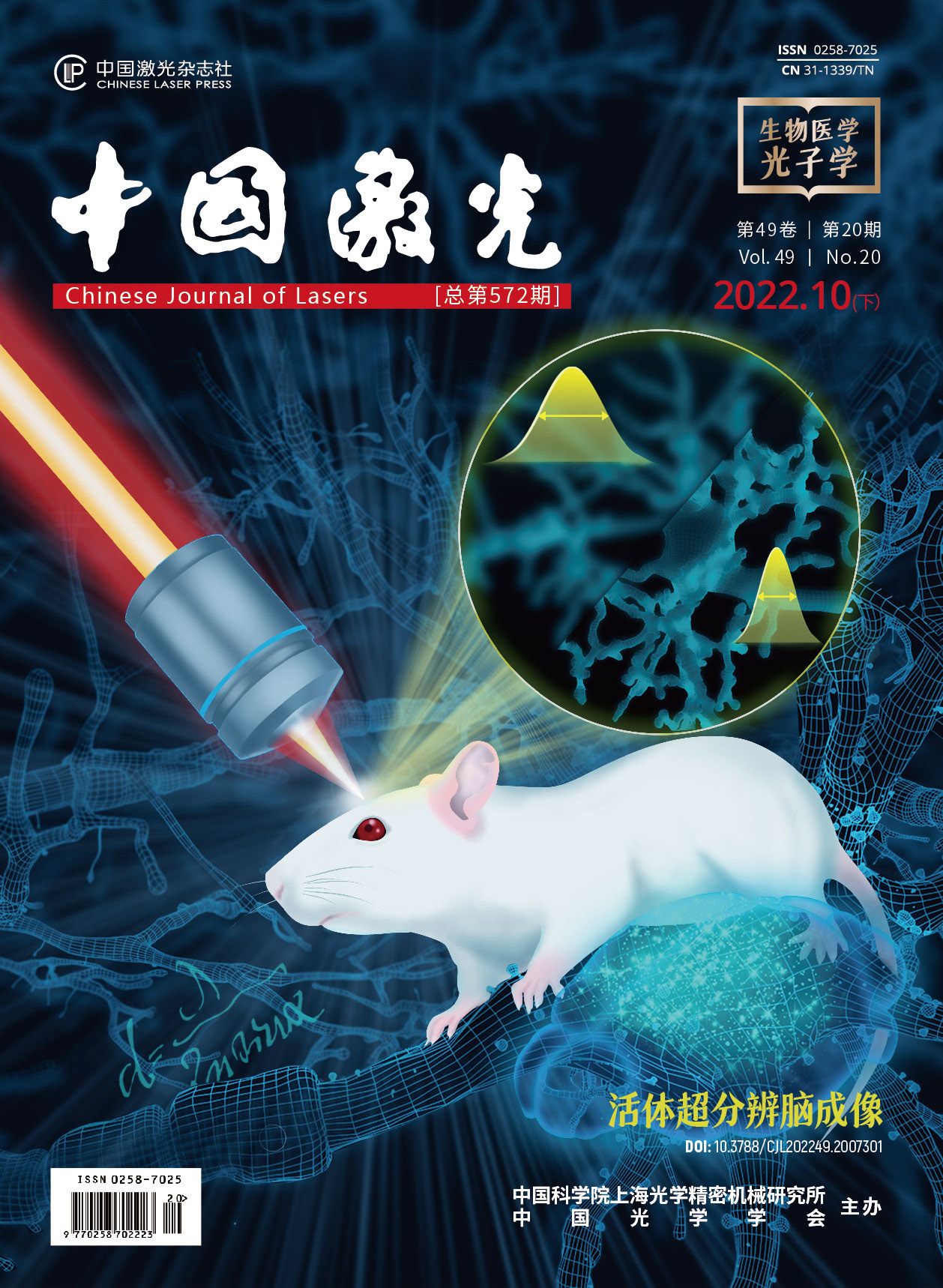基于OCT的昆虫心脏功能参数自动检测定量分析方法  下载: 654次封底文章
下载: 654次封底文章
Cardiovascular is one of the major diseases that threatens human health, and the prevalence of cardiovascular disease in China continues to grow. Therefore, it is important to select an appropriate model organism to understand the development of the heart. Locust has the characteristics of easy operation, strong plasticity, and short development cycle as well as the similar gene regulation mechanism with human beings in the process of cardiac development, therefore it becomes a useful candidate for studying the cardiac function and for the pathological gene analysis. Researchers have proposed a variety of methods to evaluate the heart function of insects, such as multi-sensor electrocardiogram, atomic force microscope monitoring, and electrical stress method. However, these methods are invasive and cannot monitor the same living body continuously. Therefore, a method which can monitor the heart development and screen the phenotypic variation of insects or other model organisms non-invasively is more desiderated. Fortunately, optical coherence tomography (OCT), widely used in biomedical detection because of its noninvasiveness, real-time, and high resolution, can be used to detect the internal structures of biological tissues and other non-uniform scatterers. Therefore, it is a more suitable tool to monitor the embryonic heart development of a locust. In addition, the measurement of cardiac function parameters (such as heart rate) still needs to be calculated manually by the M-Mode diagram, which is not only time-consuming but also prone to errors. Therefore, a high efficiency automatic detection algorithm is a critical issue to be solved urgently in the high-throughput screening and phenotypic analysis of model biological pathogenic genes.
Using a locust as the model organism, in our previous works we have monitored the embryo development and screened the phenotypic variation caused by the RNAi technology. Here, a new method is proposed to automatically and quickly calculate the insect heart function parameters, such as end diastolic diameter (EDD), end systolic diameter (ESD), end diastolic area (EDA), end systolic area (ESA) and heart rate (HR). The processing flow is shown in Fig. 2. The collected 3D data are expanded in time series to obtain the M-Mode diagram of the embryo heart chamber. After gray-scale transformation of the M-Mode diagram, by a series of operations including threshold-segmentation-based regional growth, boundary recognition, morphological processing, and feature peak extraction, the parameters including HR, EDD and ESD can be obtained.
The low-frequency noise in the original M-Mode image [Fig. 3(a)] is removed after gray-scale transformation [Fig. 3(b)], which is beneficial for the calculation by the regional growth algorithm. Then, any point selected in the fetal heart ventricle [the red dot in Fig. 3(c)] can be used as the initial seed point, and the binary regional growth result can be obtained under the specified regional growth criterion [Fig. 3(d)]. As shown in Fig. 3(d), there are burrs at the edge of the ventricle caused by the non-uniformity of the grayscale distribution, which adversely influences the accuracy in obtaining the heart beat amplitude in the next step. To solve this problem, morphological processing is introduced, which plays a good role in smoothing the cavity edge. The image after removing burrs is shown in Fig. 3(e). By counting the numbers of pixels with the logical value of 0 in A-scan and knowing the size of single pixel, the beat amplitude of the heart at different moments can be obtained [Fig. 3(f)]. As shown in Fig. 3(g), the HR, EDD, and ESD cardiac parameters can be calculated after the extreme points are found by the peak extraction algorithm. If the original image is changed from the M-Mode image to the B-scan image of the cross section of the embryonic heart, the maximum EDA and the minimum ESA of the locust embryonic heart can be calculated according to the steps in section 2.2, as shown in Fig. 6. Therefore, one can automatically detect and quantitatively analyze the heart function parameters of insect embryos by the proposed algorithm.
In the field of heart development and mechanism of heart disease, OCT has been successfully applied to detect the heart function of model organisms such as insects due to its advantages of noninvasiveness, real-time, and high resolution. However, the detection algorithm still has some problems, such as low efficiency, high requirements on image quality, and inaccuracy of measurement, especially it is not suitable for the detection under a large sample size. In this paper, we propose a high speed automatic detection and quantitative analysis algorithm of insect cardiac function parameters by OCT. The position of the seed point is determined through human-computer interaction, and a series of processing such as automatic image segmentation and target region division are performed on the OCT M-Mode image of the insect heart. The proposed algorithm can quickly and accurately measure the cardiac function parameters including the end diastolic diameter, end systolic diameter, end diastolic area, end systolic area, and heart rate. This method can improve the screening and analysis efficiency of pathogenic genes in high-throughput biological samples and has important applicable value in the research of cardiovascular disease using insects as model organisms.
王秀丽, 杜若瑄, 姚晓天, 苏亚, 崔省伟, 郝鹏, 杨丽君, 段兵兵. 基于OCT的昆虫心脏功能参数自动检测定量分析方法[J]. 中国激光, 2022, 49(20): 2007202. Xiuli Wang, Ruoxuan Du, X.Steve Yao, Ya Su, Shengwei Cui, Peng Hao, Lijun Yang, Bingbing Duan. Automatic Detection and Quantitative Analysis of Insect Cardiac Function Parameters Using OCT[J]. Chinese Journal of Lasers, 2022, 49(20): 2007202.







